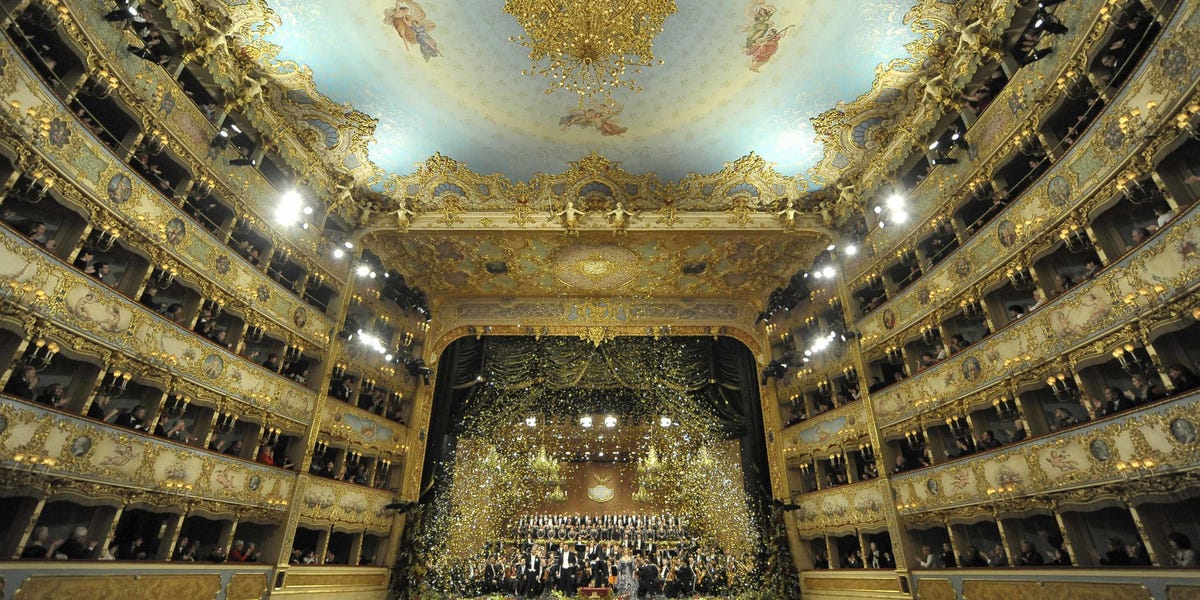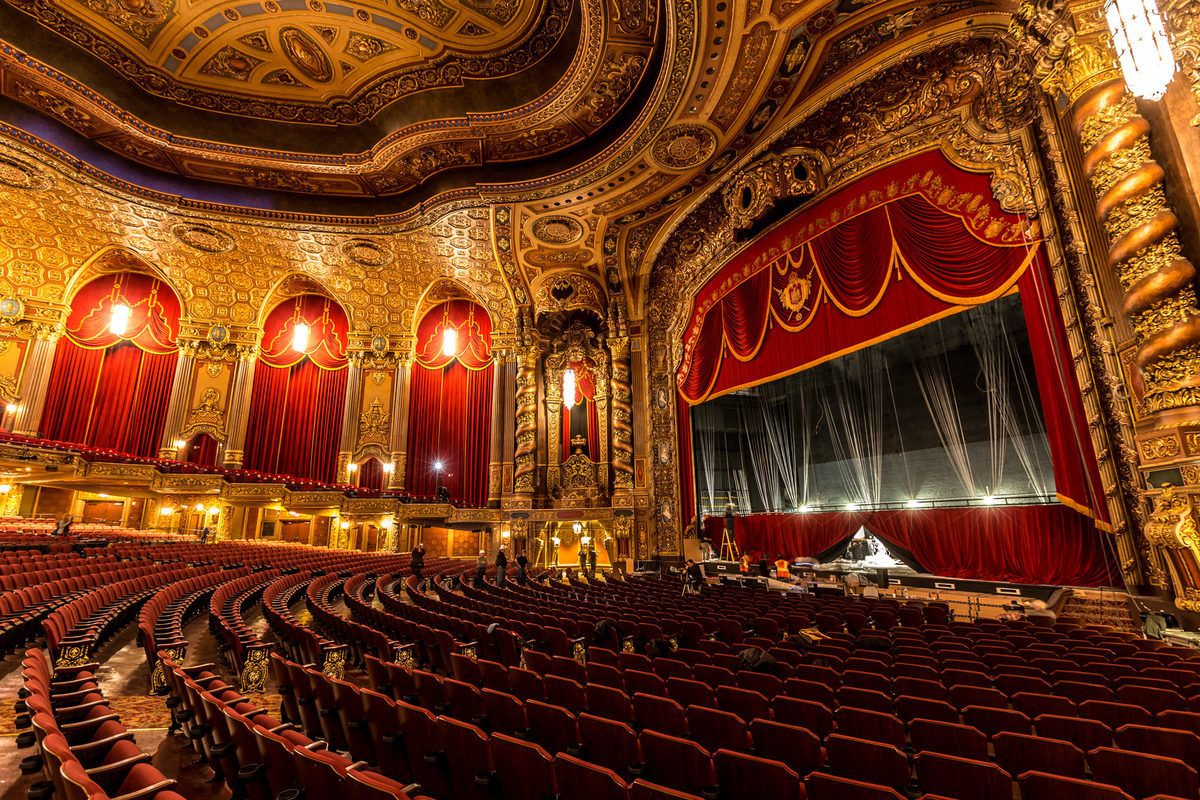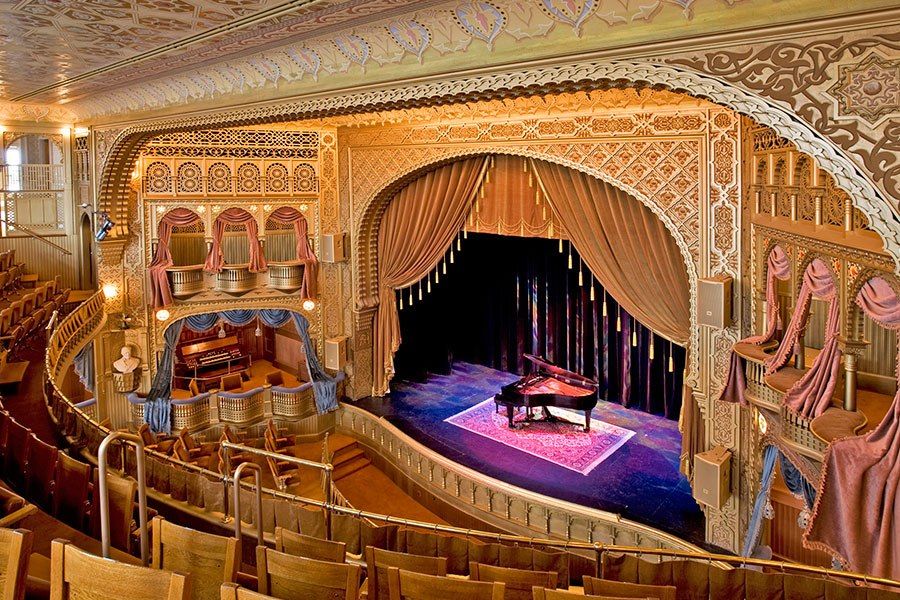Top 10 Most Beautiful Theatre Restorations in the USA sets the stage for an exploration of meticulously restored gems that breathe new life into the country’s rich theatrical history. From architectural marvels to cultural landmarks, these top 10 picks promise a visual feast for enthusiasts and history buffs alike.
The following paragraphs delve into the unique features and stories behind each meticulously restored theatre, shedding light on the intricate process of preserving these architectural wonders for future generations to enjoy.
Overview of Theatre Restorations
Theatre restorations in the USA have a rich history dating back to the early 20th century when many historic theatres were built across the country. These theatres served as cultural hubs, hosting various performances ranging from plays to musicals, and even silent films.
Preserving historic theatres is crucial as they hold significant architectural and cultural value. These buildings often showcase exquisite craftsmanship and design that reflect the time period in which they were constructed. By restoring these theatres, we can ensure that future generations have the opportunity to experience the charm and elegance of the past.
Importance of Preserving Historic Theatres
Restored theatres play a vital role in revitalizing local communities. They serve as gathering places for residents and visitors alike, fostering a sense of community pride and cultural appreciation. Additionally, these theatres contribute to the economic development of their surrounding areas by attracting tourists and generating revenue for local businesses.
Impact of Restored Theatres on Local Communities and Tourism
Restored theatres often become iconic landmarks that draw both locals and tourists. They offer a unique and immersive cultural experience, showcasing a blend of history and modern entertainment. The presence of these theatres can significantly boost tourism, attracting visitors who are eager to explore the rich cultural heritage of a region.
Criteria for Selecting the Top 10 Most Beautiful Theatre Restorations
- Architectural significance and historical value
- The extent of restoration work done
- Aesthetic appeal and preservation of original design elements
- Community impact and engagement
- Sustainability and long-term preservation plans
Paramount Theatre, Oakland, CA
The Paramount Theatre in Oakland, California, is a stunning example of Art Deco architecture that has been lovingly restored to its former glory.
Architectural Style
The Paramount Theatre showcases the elegant Art Deco style, characterized by geometric shapes, bold colors, and intricate detailing. The theater’s facade features a grand marquee, ornate terra cotta decorations, and a towering neon sign that lights up the night sky.
Key Features of Restoration
- The restoration of the Paramount Theatre focused on preserving the original Art Deco elements, such as the stunning murals, intricate ceiling designs, and plush velvet seating.
- State-of-the-art sound and lighting systems were installed to enhance the audience’s experience while maintaining the historic charm of the theater.
- The iconic neon sign was meticulously restored to its former brilliance, becoming a beacon of light in downtown Oakland once again.
Unique Challenges
During the restoration process, one of the unique challenges faced was sourcing materials that matched the original Art Deco design. From custom-made light fixtures to hand-painted murals, every detail had to be carefully recreated to ensure historical accuracy.
Significance in the Local Community
The Paramount Theatre holds a special place in the hearts of Oakland residents, serving as a cultural hub and a symbol of the city’s rich history. It hosts a variety of performances, from Broadway shows to concerts, attracting audiences from near and far. The restoration of the Paramount Theatre not only preserved a piece of architectural history but also revitalized the downtown area, bringing new life and energy to the community.
Kings Theatre, Brooklyn, NY

Kings Theatre in Brooklyn, NY, underwent a remarkable restoration project that brought new life to this historic venue. The restoration not only preserved the architectural beauty of the theater but also enhanced its cultural significance for the community.
Overview of the Kings Theatre Restoration Project
The restoration of Kings Theatre was a massive undertaking that began in 2013 and was completed in 2015. The project aimed to restore the theater to its former glory, while also updating it with modern amenities to ensure a top-notch entertainment experience for patrons.
- Restoration involved meticulous work to repair and recreate the intricate details of the theater’s original design, including ornate plasterwork, grand chandeliers, and rich color schemes.
- New seating, lighting, and sound systems were installed to enhance the audience’s comfort and enjoyment without compromising the historical integrity of the theater.
Historical Background of the Kings Theatre
Originally opened in 1929, Kings Theatre was a grand movie palace designed by architect Rapp and Rapp. The theater showcased vaudeville acts, movies, and live performances, becoming a cultural hub for the Brooklyn community.
- After decades of neglect and disrepair, the theater closed its doors in 1977 and remained abandoned for nearly 40 years.
- The restoration project aimed to revive the theater’s former glory and provide a space for a wide range of cultural events, from Broadway shows to concerts and community gatherings.
Before and After Comparison of the Restoration
The transformation of Kings Theatre before and after the restoration is truly astounding, showcasing the dedication and craftsmanship that went into preserving this historic landmark.
- Before the restoration, the theater was in a state of disrepair, with faded paint, crumbling plaster, and outdated facilities.
- After the restoration, Kings Theatre emerged as a stunning blend of historic grandeur and modern amenities, with meticulous attention to detail that preserved its original beauty.
Cultural Impact of the Restored Kings Theatre
The restored Kings Theatre has had a significant cultural impact on the Brooklyn community and beyond, serving as a vital cultural and entertainment hub that celebrates the arts and history.
- The theater now hosts a diverse array of performances, from Broadway shows and concerts to community events and film screenings, attracting a wide audience and enriching the local cultural scene.
- By preserving the historical significance of Kings Theatre and providing a platform for artistic expression, the restoration has helped revitalize the community and foster a sense of pride and connection among residents.
Chicago Theatre, Chicago, IL
The Chicago Theatre, located in the heart of the Windy City, is a true architectural gem that stands as a symbol of Chicago’s rich cultural heritage.The iconic features of the Chicago Theatre include its stunning marquee, which lights up the bustling streets of downtown Chicago, and its lavish interior decor inspired by the French Baroque style. The theater’s famous vertical sign, with the words “Chicago” and “Theatre” brightly illuminated, is a beloved landmark in the city.The restoration efforts undertaken to preserve the grandeur of the Chicago Theatre were extensive and meticulous.
The restoration project included repairing and repainting the intricate plasterwork, restoring the elegant light fixtures, and refurbishing the luxurious seating in the auditorium. The goal was to recreate the opulence and grandeur of the theater’s early days while incorporating modern amenities for the comfort of today’s audiences.Interesting facts about the history of the Chicago Theatre include its opening in 1921 as a movie palace and vaudeville venue, hosting legendary performers such as Frank Sinatra, Dean Martin, and Judy Garland.
The theater was designated a Chicago Landmark in 1983 and added to the National Register of Historic Places in 1979.The Chicago Theatre plays a vital role in the city’s cultural scene, serving as a premier venue for a wide range of performances, including concerts, comedy shows, and Broadway productions. Its iconic marquee and rich history make it a must-visit destination for both locals and tourists, contributing to the vibrant arts and entertainment landscape of Chicago.
The Orpheum Theatre, New Orleans, LA
The Orpheum Theatre in New Orleans, LA, stands as a magnificent piece of architectural history, boasting unique elements that make it a cultural gem in the city.
Unique Architectural Elements
The Orpheum Theatre features stunning Beaux-Arts architecture, characterized by its intricate detailing, grand columns, and ornate decorations. The interior showcases lavish designs with intricate moldings, chandeliers, and a majestic domed ceiling, transporting visitors to a bygone era of opulence.
Challenges in Restoration
Restoring the Orpheum Theatre presented various challenges, from sourcing historically accurate materials to preserving delicate frescoes and intricate carvings. The restoration team had to navigate the delicate balance between modern amenities and preserving the historic integrity of the theater, ensuring that every detail was meticulously attended to.
Cultural Significance
The Orpheum Theatre holds immense cultural significance in New Orleans, serving as a hub for artistic performances, community gatherings, and entertainment for generations. It has hosted legendary performances by renowned artists and continues to be a beloved venue for locals and visitors alike, contributing to the vibrant cultural tapestry of the city.
Anecdotes and Stories, Top 10 Most Beautiful Theatre Restorations in the USA
During the restoration of the Orpheum Theatre, workers uncovered hidden artifacts, including old playbills, vintage costumes, and even a forgotten trap door used by performers in the early days of the theater. These discoveries added a layer of mystery and intrigue to the restoration process, offering glimpses into the rich history and theatrical magic that the Orpheum Theatre has witnessed over the years.
Ohio Theatre, Columbus, OH
Ohio Theatre in Columbus, Ohio, underwent a remarkable restoration process that brought back its original grandeur and charm.
Restoration Process
- The restoration of the Ohio Theatre involved meticulous efforts to preserve its historic architecture, including ornate details and decorative elements.
- Skilled craftsmen and artisans were employed to replicate and restore original features such as intricate plasterwork, gilding, and intricate moldings.
- State-of-the-art technology was also utilized to ensure the structural integrity of the building while maintaining its historical authenticity.
Community Involvement
- The community in Columbus actively participated in fundraising efforts to support the restoration of the Ohio Theatre, showcasing a strong commitment to preserving their cultural heritage.
- Volunteers and local organizations played a crucial role in advocating for the preservation of the theatre, organizing events and campaigns to raise awareness and funds for the project.
- The collaboration between the community and preservationists helped create a sense of ownership and pride in the Ohio Theatre’s restoration.
Comparison to Other Historic Theatres
- The Ohio Theatre stands out among historic theatres in the USA for its meticulous restoration process that retained the original charm and elegance of the building.
- Compared to other theatres, the Ohio Theatre’s restoration efforts were comprehensive, focusing on both the interior and exterior details to recreate the ambience of its early days.
- The dedication to historical accuracy and attention to detail set the Ohio Theatre apart as a shining example of successful preservation of a cultural landmark.
Awards and Recognition
- The restoration of the Ohio Theatre has received numerous awards and recognition for its outstanding achievement in preserving a significant piece of American architectural history.
- Notable accolades include awards for historic preservation, architectural excellence, and community engagement, highlighting the widespread acclaim for the restoration efforts.
- By garnering prestigious awards, the Ohio Theatre has solidified its position as a premier restored theatre in the USA, celebrated for its beauty and historical significance.
Los Angeles Theatre, Los Angeles, CA
The Los Angeles Theatre, located in the heart of downtown Los Angeles, is a stunning example of historic architecture that has played a significant role in the entertainment industry for decades.
Architectural Elements
The Los Angeles Theatre is known for its extravagant French Baroque style, featuring ornate plasterwork, gilded details, and a breathtaking grand staircase. The theater’s stunning chandeliers, intricate ceiling murals, and luxurious velvet drapes add to its opulent charm.
Significance in the Entertainment Industry
The Los Angeles Theatre has been a premier venue for film premieres, live performances, and special events since its opening in 1931. It has hosted countless Hollywood stars and industry events, solidifying its place in entertainment history.
Challenges in Restoration
Restoring a historic theatre in a bustling city like Los Angeles comes with its own set of challenges, including navigating strict preservation guidelines, sourcing authentic materials for renovation, and coordinating with local authorities to ensure the building meets safety standards while preserving its architectural integrity.
Special Events Post-Restoration
After undergoing a meticulous restoration process, the Los Angeles Theatre continues to host a variety of special events, including film screenings, live performances, and galas. It remains a popular venue for both locals and tourists looking to experience the glamour and history of old Hollywood.
Saenger Theatre, New Orleans, LA
The Saenger Theatre in New Orleans, Louisiana, underwent a major restoration project that aimed to bring back its former glory and charm. The project, completed in 2013, restored the theatre to its original 1927 grandeur while incorporating modern amenities to enhance the overall experience for patrons.
Architectural Features of Saenger Theatre
The Saenger Theatre is known for its stunning architectural details, including a grand lobby with marble floors, crystal chandeliers, and intricate plasterwork. The main auditorium boasts a ceiling adorned with twinkling stars, ornate balconies, and a beautifully restored proscenium arch. The overall design reflects a mix of Italian Renaissance and Spanish Baroque styles, creating a truly unique and opulent space.
Comparison to Other Restored Theatres
When compared to other restored theatres in the USA, the Saenger Theatre stands out for its blend of historic charm and modern amenities. While preserving its original architectural features, the theatre has been updated with state-of-the-art sound and lighting systems, comfortable seating, and improved accessibility. This balance between preservation and modernization sets the Saenger Theatre apart from many other restored venues.
Economic Impact on Local Economy
The restored Saenger Theatre has had a significant economic impact on the local economy in New Orleans. By attracting top Broadway shows, concerts, and events, the theatre has increased tourism to the area, benefiting local businesses such as restaurants, hotels, and shops. The revitalization of the Saenger Theatre has also created jobs in the entertainment industry and boosted the overall cultural scene in the city.
This economic revitalization has helped to further solidify New Orleans as a premier destination for arts and entertainment in the USA.
The Fox Theatre, Atlanta, GA

The Fox Theatre in Atlanta, Georgia, holds a significant place in the city’s cultural history as a beloved entertainment venue that has stood the test of time. Originally opened in 1929, the Fox Theatre has been a hub for live performances, concerts, and film screenings, attracting audiences from near and far.
History and Significance
The Fox Theatre is a prime example of the opulent and grand architectural style of the 1920s. Designed by architect Olivier Vinour, the theatre features a unique blend of Moorish, Egyptian, and Spanish architectural elements, creating a visually stunning and one-of-a-kind aesthetic. The elaborate details, intricate carvings, and vibrant colors of the interior transport visitors to a bygone era of glamour and luxury.
Unique Architectural Style
The Fox Theatre’s distinctive design elements include a soaring domed ceiling adorned with celestial motifs, ornate chandeliers, and intricate plasterwork throughout the building. The exterior of the theatre is equally impressive, with a terra cotta facade, minarets, and a marquee that lights up Peachtree Street in the heart of Atlanta.
Innovative Restoration Techniques
The restoration of the Fox Theatre in the 1970s was a massive undertaking that required innovative techniques to preserve the historic integrity of the building. One of the most notable restoration efforts was the repair and refurbishment of the iconic Mighty Mo Wurlitzer organ, which had fallen into disrepair over the years. The restoration team used a combination of traditional craftsmanship and modern technology to bring the organ back to its former glory, ensuring that it could once again fill the theatre with its majestic sound.
Community Reaction
The restoration of the Fox Theatre was met with overwhelming support and enthusiasm from the local community, who recognized the importance of preserving this cultural landmark for future generations. The reopening of the Fox Theatre in 1975 marked a new chapter in the theatre’s history, as it once again became a thriving center for the performing arts in Atlanta.
Today, the Fox Theatre continues to delight audiences with its world-class productions and timeless charm.
The Beacon Theatre, New York, NY
The Beacon Theatre in New York, NY, underwent a remarkable transformation after its restoration, breathing new life into this historic venue. Efforts to preserve the Beacon Theatre’s original charm were meticulous and thorough. From the intricate detailing on the ceilings to the ornate designs on the walls, every aspect of the theater was carefully restored to its former glory.During the restoration process, technical aspects played a crucial role in ensuring the integrity of the building.
Modern sound and lighting systems were seamlessly integrated while maintaining the theater’s classic aesthetic. The acoustics were also enhanced to provide an unparalleled audio experience for audiences.One of the most notable aspects of the Beacon Theatre post-restoration is the lineup of famous performances and events held there. From iconic concerts by legendary musicians to special events featuring renowned speakers, the Beacon Theatre has once again become a cultural hub in New York City.
Conclusion

As the curtains draw to a close on this captivating journey through the Top 10 Most Beautiful Theatre Restorations in the USA, one thing is clear: these architectural marvels not only stand as testaments to the past but also serve as vibrant hubs of culture and community in the present day. Each theatre’s restoration is a labor of love, preserving history in a way that continues to captivate audiences for years to come.
Popular Questions: Top 10 Most Beautiful Theatre Restorations In The USA
What criteria were used to select the top 10 most beautiful theatre restorations?
The top 10 most beautiful theatre restorations were selected based on a combination of architectural significance, historical importance, community impact, and the level of restoration effort put into each project.
How do restored theatres impact local communities and tourism?
Restored theatres often serve as cultural hubs within their communities, hosting a variety of events and performances that attract locals and tourists alike. They contribute to the cultural vibrancy of an area and can boost tourism by offering unique historical experiences.
What are some unique challenges faced during theatre restoration projects?
Theatre restoration projects often encounter challenges such as funding constraints, preservation of original architectural elements, navigating historical regulations, and balancing modern amenities with historic charm.




